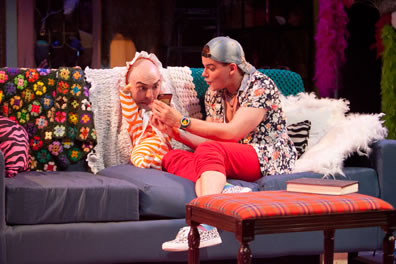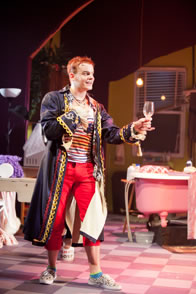A Tale of Two Cities
An Epoch of Belief and Incredulity
By Everett Quinton
Synetic Theater, Arlington, Virginia
Friday, May 15, 2015, C-105&106 (center stalls)
Directed by Serge Seiden

Jerry (Alex Mills, right) shows Baby (Vato Tsikurishvili) pictures on his cell phone in Synetic's production of A Tale of Two Cities. Below, Jerry acts out one of the characters in the novel as an elaborate attempt to get Baby to fall asleep so that Jerry can get to his drag queen show. Photos by Koko Lanham, Synetic Theater.
The premise seems a head scratcher. A drag queen named Jerry finds an abandoned baby on his apartment doorstep. To get the baby to sleep so that he can get to his show that evening, Jerry acts out Charles Dickens' A Tale of Two Cities in its entirety (actually, he bases his interpretation on the 1935 film starring Ronald Colman). The play was created by Everett Quinton of New York's Ridiculous Theatrical Company as an Off-Broadway piece in 1988.
The promise is more enticing: seeing Alex Mills as Jerry. This young actor and dancer is a budding star in the D.C. theater scene, from his poetic physicality that leaves Synetic Theater audiences breathless in that company's Silent Shakespeare productions to the more traditional acting abilities he showcased in Signature's production of Shakespeare's R&J. We had no idea what we were in for, but we figured a one-man show of Mills dancing and miming A Tale of Two Cities was a sure thing.
Well, it was and it wasn't.
Except for a striptease in the middle and his burlesque act at the end, Mills does no dancing. He acts out the novel, pirouetting from character to character as he speaks their lines. Nor is it a one-man show. The baby is real—or, more accurately, the baby is human. That, it turns out, is the best of times.
As Jerry carries the bassinette into his apartment—"What the gay hell?" he says—we hear crying that certainly sounds live. Then, in a bit of unexpected stagecraft requiring a spoiler alert (click here for details), Synetic's leading clown, Vato Tsikurishvili, has appeared as Baby (his given name is Dorian, but "oh, Baby" becomes Jerry's nervous catchphrase).
The next 10 minutes of Mills' Jerry interacting with Tsikurishvili's Baby is one of the funniest passages of time I've spent in a theater. I can only recall three Bottoms that made me laugh as loud. And speaking of bottoms, we get a full look at what supposedly comes out of this Baby's bottom before the clueless Jerry tosses the offending diaper out the window and we hear an offended passerby screech on the street below. Baby sucks his own thumb, then sucks Jerry's thumb, then tries to eat Jerry's thumb, and nervously watches Jerry prepare him a real dinner. While Jerry is speaking on the phone, he gives Baby his keys to play with to keep him from crying, and when Baby tosses the keys, Jerry hands him another item from his pocket, a cigarette lighter, which Baby promptly puts in his mouth.
Having never even heard of the show before Synetic announced it as a last-minute replacement for its final installment in the 2014–2015 season, I have no idea how much of the staging originated with Quinton and how much with Serge Seiden, who directed this production (he also served as stage manager for a 1991 production at Studio Theater in Washington, D.C.). The original Off-Broadway version received rave reviews and awards, mainly due to Quinton's ballsy premise. There is much wisdom in all this seeming foolishness as Dickens' tale becomes intertwined with that of a drag queen surviving in 1980s New York (a tale of two cities in its own way, a gay community existing in the shadows of a straight community). But no other performer—i.e., no visible Baby—is mentioned as participating in that first show. Tellingly, Mills is alone in Synetic's advance publicity of its production, so we don't learn of Tsikurishvili's playing Baby until we open our program and see the cast list and bios. Even then, his appearance is a complete surprise.
Adding the baby, and Tsikurishvili's performance of Baby, puts this production over the top—literally and figuratively speaking. Seiden fills out the play with a number of humorous bits, such as Jerry sticking a feather in an empty Cheerios box to use as the hat of the snobbish aristocrat Marquis St. Evrémonde. "Work with me," Mills says as he reshapes the cereal box for its new purpose. Key details are in the apartment designed by Luciana Stecconi, featuring a purple couch, a pink bathtub, a kitchenette, and a desk that serves as Jerry's makeup table with a lace shawl draped over the front. Posters of A Tale of Two Cities, Ronald Colman, and Breakfast at Tiffany's adorn the wall; video cassettes of A Tale of Two Cities and The Birds lie on the cushion-topped coffee table; mannequins stand about wearing boas; and we see at least 10 wigs of various colors, representing Jerry's other vocation as a wigmaker. Props to Props Master Amy Kellett.
That Baby has access to a knife and a pistol is a bit weird, but it's funny nonetheless. Baby also completely disappears during the more dramatic moments of Jerry's re-creation of Dickens' tale. This is perhaps intended to ensure that the audience's attention stays focused on Mills playing Jerry playing everybody in Two Cities, but not only does that indicate the power of Tsikurishvili's performance as Baby, the fact we notice he's missing in these moments is notable in itself.
 When Jerry is talking on the phone with friends and interacting with Baby, Mills is a hoot. He does direct address with the audience, and at times he seems to slip into improvisation; whether it's rehearsed or not it gives the show a bit more sense of in-the-moment intimacy and theatrical danger. When Jerry is acting out Two Cities, Mills is strained beyond the current limit of his talents. He makes a game effort at pulling off the near impossible, playing every character in Dickens' book as distinctively as possible, all while fixing dinner, undressing (in a dance that will thrill anybody of any gender and sexual orientation), bathing (using shaving cream as part of his act, much to Baby's consternation), and then putting on his makeup and costume for his show. However, it's not so much a tour de force performance as a trip into the future showcase. Mills has the stuff to be as great an actor as he is a dancer (I rank him a notch below Baryshnikov and Nureyev among theatrical dancers I've seen in person), but his talent hasn't yet developed to a point where he makes each of Dickens' characters fully engaging. That he doesn't might be purposeful—that it's not Mills but Jerry playing all these parts—but the result is the same: The play drags during the longer Dickensonian passages.
When Jerry is talking on the phone with friends and interacting with Baby, Mills is a hoot. He does direct address with the audience, and at times he seems to slip into improvisation; whether it's rehearsed or not it gives the show a bit more sense of in-the-moment intimacy and theatrical danger. When Jerry is acting out Two Cities, Mills is strained beyond the current limit of his talents. He makes a game effort at pulling off the near impossible, playing every character in Dickens' book as distinctively as possible, all while fixing dinner, undressing (in a dance that will thrill anybody of any gender and sexual orientation), bathing (using shaving cream as part of his act, much to Baby's consternation), and then putting on his makeup and costume for his show. However, it's not so much a tour de force performance as a trip into the future showcase. Mills has the stuff to be as great an actor as he is a dancer (I rank him a notch below Baryshnikov and Nureyev among theatrical dancers I've seen in person), but his talent hasn't yet developed to a point where he makes each of Dickens' characters fully engaging. That he doesn't might be purposeful—that it's not Mills but Jerry playing all these parts—but the result is the same: The play drags during the longer Dickensonian passages.
It's not just us that grow weary with Jerry: Baby finally goes to sleep. But the show goes on (it clocks in at about 100 minutes with no intermission) as we are treated to Jerry's drag queen show in full costume choreographed by Synetic's co-founder Irina Tsikurishvili. It's fun but traditional, not the cutting-edge stuff we normally see her chart out for Synetic's Silent Shakespeare productions or, for that matter Jerry stripping down for his bath in this production. Oh, Baby!
Hope, of course, springs eternal. This show is a step on a path to certain greatness for Mills. Meanwhile, Vato Tsikurishvili, in his infancy, reaches a new peak in his Synetic repertoire. And that's something to see.
Eric Minton
May 22, 2015
Comment: e-mail editorial@shakespeareances.com
Start a discussion in the Bardroom



 Find additional Shakespeareances
Find additional Shakespeareances